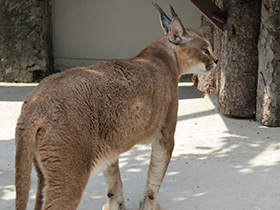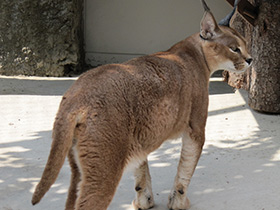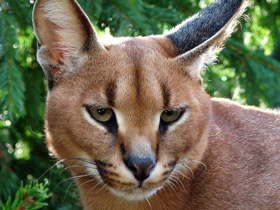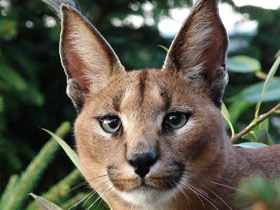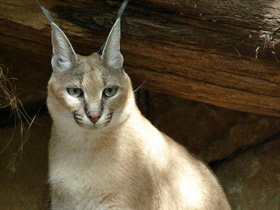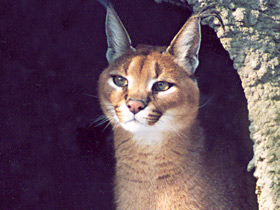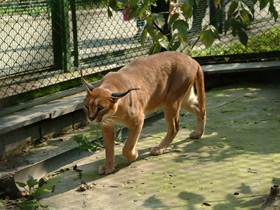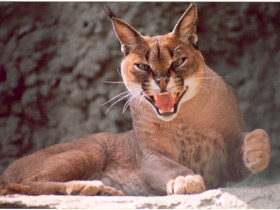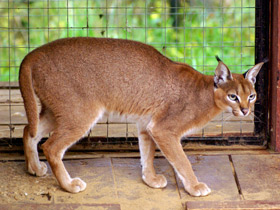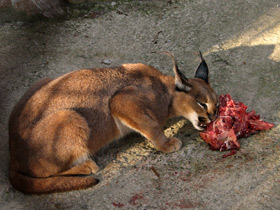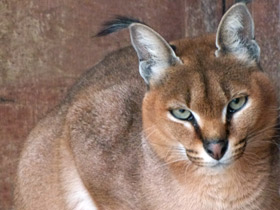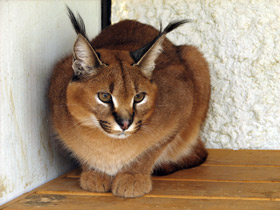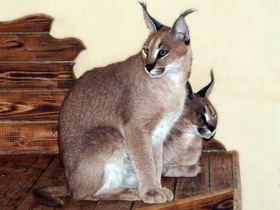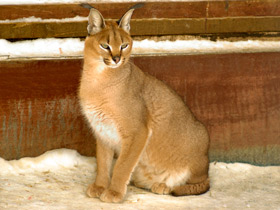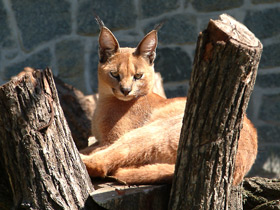The caracal (Caracal caracal)
The caracal (Caracal caracal) (/ˈkærəkæl/) is a medium-sized wild cat native to Africa, the Middle East, Central Asia, and arid areas of Pakistan and northwestern India.
Appearance
Caracal caracal is a species of carnivorous mammal in the genus Caracal, family Felidae. It is one of the most secretive and mysterious members of the feline family. Its name is due to the black colour of its tassels and the back of its ears: Turkish for "black ear".
The caracal resembles the lynx in appearance, but is smaller, slimmer and monochromatic in colour. It is between 65 and 90 cm long and weighs between 11 and 19 kg, and males are larger than females. The only distinguishing features of the caracal are its large ears, which end in unusually long tassels of 5 cm, and its strongly developed hind legs, with which it can leap five metres from one place.
The caracal also has a stiff brush of hair on its paws, which facilitates movement in the sand. The fur of this southern cat is short and thick, and its colour resembles that of the puma; zoologists believe that the caracal is close to it in some morphological features.
Etymology
The name 'caracal' was proposed by Georges Buffon in 1761 who referred to its Turkish name 'Karrah-kulak' or 'Kara-coulac', meaning 'black ears'. The 'lynx' of the Greeks and Romans was most probably the caracal, and the name 'lynx' is sometimes still applied to it, but the present-day lynx proper is a separate genus.
The caracal is also known as desert lynx and Persian lynx.
Local names
Its name in the Tigrinya language is ጭክ ኣንበሳ, ch’ok anbessa, which means 'bearded lion'. In the Emirati Dialect of Arabic, its name is الوشق الصحراوي (al Washq al Ṣaḥrāwī), translating directly to 'desert lynx'.
Taxonomy and phylogeny
Felis caracal was the scientific name used by Johann Christian Daniel von Schreber in 1776 who described a caracal skin from the Cape of Good Hope. In 1843, John Edward Gray placed it in the genus Caracal. It is placed in the family Felidae and subfamily Felinae.
In the 19th and 20th centuries, several caracal specimens were described and proposed as subspecies. Since 2017, three subspecies have been recognised as valid:
- Southern caracal (Caracal caracal caracal) (Schreber, 1776) – occurs in Southern and East Africa;
- Northern caracal (Caracal caracal nubicus) (Fischer, 1829) – occurs in North and West Africa;
- Asiatic caracal (Caracal caracal schmitzi) (Matschie, 1912) – occurs in Asia.
Distribution and habitat
In Africa, the caracal is widely distributed south of the Sahara, but considered rare in North Africa. In Asia, it occurs from the Arabian Peninsula, Middle East, Turkmenistan, Uzbekistan to western India. It inhabits forests, savannas, marshy lowlands, semideserts, and scrub forests, but prefers dry areas with low rainfall and availability of cover. In montane habitats such as in the Ethiopian Highlands, it occurs up to an elevation of 3,000 m (9,800 ft).
In Ethiopia's Degua Tembien massif, they can be seen along roads, sometimes as roadkills.
In the Emirate of Abu Dhabi, a male caracal was photographed by camera traps in Jebel Hafeet National Park in Al Ain Region, in spring 2019, the first such record since the mid-1980s.
In south-western Turkey, caracals are present in a wildlife reserve in the provinces of Antalya and Muğla that is regularly used for recreational and agricultural activities. However, they avoid humans and are active mostly at night. In Uzbekistan, caracals were recorded only in the desert regions of the Ustyurt Plateau and Kyzylkum Desert. Between 2000 and 2017, 15 individuals were sighted alive, and at least 11 were killed by herders.
In Iran, the caracal has been recorded in Abbasabad Naein Reserve, Bahram’gur Protected Area, Kavir National Park and in Yazd Province.
In India, the caracal occurs in Sariska Tiger Reserve and Ranthambhore National Park.
Hunting and feeding
Despite its modest size, the caracal is a dangerous and powerful predator, an experienced and cunning hunter, capable of stalking prey twice its own weight and then, like a leopard, dragging it up a tree to hide it from its rivals. Although the caracal has long legs, it cannot run for long, so it hunts by stalking its prey and then catching up with it. Possessing extraordinary reaction speed and razor-sharp retractable claws, this agile cat is able to sneak up and dive straight into the centre of a flock and knock down several soaring birds with springy leaps. And they can strike in many ways: with both left and right paws, or with two at once; moreover, the caracal can change the direction of the leap even in flight.
This predator hunts the most diverse prey: rodents (gerbils, muskrats, moles), hares, hyraxes, small antelopes, as well as small monkeys and, rarely, reptiles. Caracals sometimes catch hedgehogs, porcupines, insects, small predatory animals such as foxes and mongooses, and young ostriches. Caracals have excellent night vision and unusually acute hearing: each ear is controlled by twenty muscles, and a multitude of hairs inside the ear help them locate their prey with great precision. The caracal is able to go for long periods without water, obtaining the liquid from the prey it eats.
In Asia, these animals were once used to hunt pheasants, peacocks, hares and small antelopes. In India, caracals were called "cheetahs for the poor" because, unlike cheetahs, they were not only kept by the rich.
Reproduction
Caracals breed throughout the year and females may have up to three pairs. After a gestation period of about 80 days, 1 to 6 (average 3) spotted, blind and deaf young are born. They are born in a den under tree roots, in a cave or in a burrow abandoned by other animals. A week after birth, the kittens' eyes open, and two to four days later they begin to stand and walk. The growth of the kittens is quite slow. During the first month, the female constantly drags them from place to place to hide them from predators. At the age of about 1 year, young caracals move away from their mother; females usually settle close to the mother's territory, while males can move up to 100 km away.
Threats
The caracal is listed as Least Concern on the IUCN Red List since 2002, as it is widely distributed in over 50 range countries, where the threats to caracal populations vary in extent. Habitat loss due to agricultural expansion, the building of roads and settlements is a major threat in all range countries. It is thought to be close to extinction in North Africa, critically endangered in Pakistan, endangered in Jordan, but stable in central and Southern Africa. Local people kill caracal to protect livestock, or in retaliation for its preying on small livestock. Additionally, it is threatened by hunting for the pet trade on the Arabian Peninsula. In Turkey and Iran, caracals are frequently killed in road accidents. In Uzbekistan, the major threat to caracal is killing by herders in retaliation for livestock losses. Guarding techniques and sheds are inadequate to protect small livestock like goats and sheep from being attacked by predators. Additionally, similarly to Ethiopia, heavy-traffic roads crossing caracal habitat pose a potential threat for the species.
Conservation
African caracal populations are listed under CITES Appendix II, while Asian populations come under CITES Appendix I. Hunting of caracal is prohibited in Afghanistan, Algeria, Egypt, India, Iran, Israel, Jordan, Kazakhstan, Lebanon, Morocco, Pakistan, Syria, Tajikistan, Tunisia, Turkey, Turkmenistan, and Uzbekistan. Caracals occur in a number of protected areas across their range.
In South Africa, the caracal is considered Least Concern, as it is widespread and adaptable to a variety of habitats. It is tolerant to human-dominated areas, although it has been persecuted for many decades. Farmers are encouraged to report sightings of caracals, both dead and alive, and livestock killed by caracals to the national Predation Management Information Centre.
The Central Asian caracal population is listed as Critically Endangered in Uzbekistan since 2009, and in Kazakhstan since 2010.
In culture
The caracal appears to have been religiously significant in the ancient Egyptian culture, as it occurs in paintings and as bronze figurines; sculptures are thought to have guarded the tombs of pharaohs. Embalmed caracals have also been discovered.

















